2014 Peugeot 508 engine
[x] Cancel search: enginePage 105 of 352
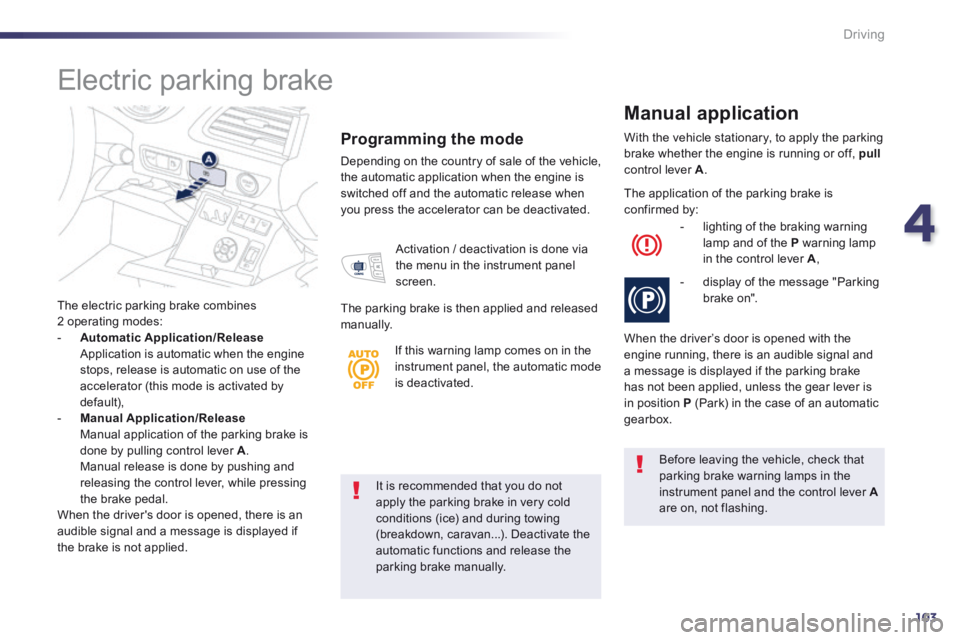
4
103
Driving
It is recommended that you do not apply the parking brake in very cold conditions (ice) and during towing (breakdown, caravan...). Deactivate the automatic functions and release the parking brake manually.
Before leaving the vehicle, check that parking brake warning lamps in the instrument panel and the control lever Aare on, not flashing.
The electric parking brake combines 2 operating modes: - Automatic Application/Release Application is automatic when the engine stops, release is automatic on use of the accelerator (this mode is activated by default), - Manual Application/Release
Manual application of the parking brake is done by pulling control lever A. Manual release is done by pushing and releasing the control lever, while pressing the brake pedal. When the driver's door is opened, there is an audible signal and a message is displayed if the brake is not applied.
Programming the mode
Depending on the country of sale of the vehicle, the automatic application when the engine is switched off and the automatic release when you press the accelerator can be deactivated.
With the vehicle stationary, to apply the parking brake whether the engine is running or off, pullcontrol lever A .
Manual application
Activation / deactivation is done via the menu in the instrument panel screen.
The parking brake is then applied and released manually.
The application of the parking brake is confirmed by:
- lighting of the braking warning lamp and of the P warning lamp in the control lever A ,
- display of the message "Parking brake on".
When the driver’s door is opened with the engine running, there is an audible signal and a message is displayed if the parking brake has not been applied, unless the gear lever is in position P (Park) in the case of an automatic gearbox.
Electric parking brake
If this warning lamp comes on in the instrument panel, the automatic mode is deactivated.
Page 106 of 352
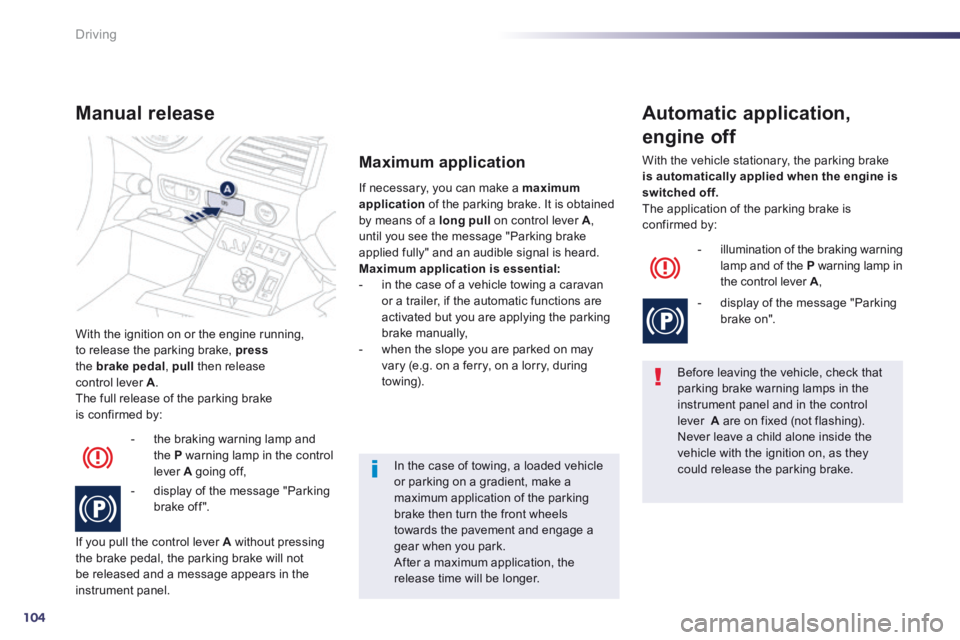
104
Driving
With the ignition on or the engine running, to release the parking brake, pressthe brake pedal , pull then release control lever A . The full release of the parking brake is confirmed by:
Manual release
- the braking warning lamp and the P warning lamp in the control lever A going off,
- display of the message "Parking brake off ".
If you pull the control lever A without pressing the brake pedal, the parking brake will not be released and a message appears in the instrument panel.
If necessary, you can make a maximum application of the parking brake. It is obtained by means of a long pull on control lever A , until you see the message "Parking brake applied fully" and an audible signal is heard. Maximum application is essential: - in the case of a vehicle towing a caravan or a trailer, if the automatic functions are activated but you are applying the parking brake manually, - when the slope you are parked on may vary (e.g. on a ferry, on a lorry, during towing).
Maximum application
Before leaving the vehicle, check that parking brake warning lamps in the instrument panel and in the control lever A are on fixed (not flashing). Never leave a child alone inside the vehicle with the ignition on, as they could release the parking brake.
Automatic application,
engine off
- illumination of the braking warning lamp and of the P warning lamp in the control lever A ,
- display of the message "Parking brake on".
With the vehicle stationary, the parking brake is automatically applied when the engine is switched off. The application of the parking brake is confirmed by:
In the case of towing, a loaded vehicle or parking on a gradient, make a maximum application of the parking brake then turn the front wheels towards the pavement and engage a gear when you park. After a maximum application, the release time will be longer.
Page 107 of 352
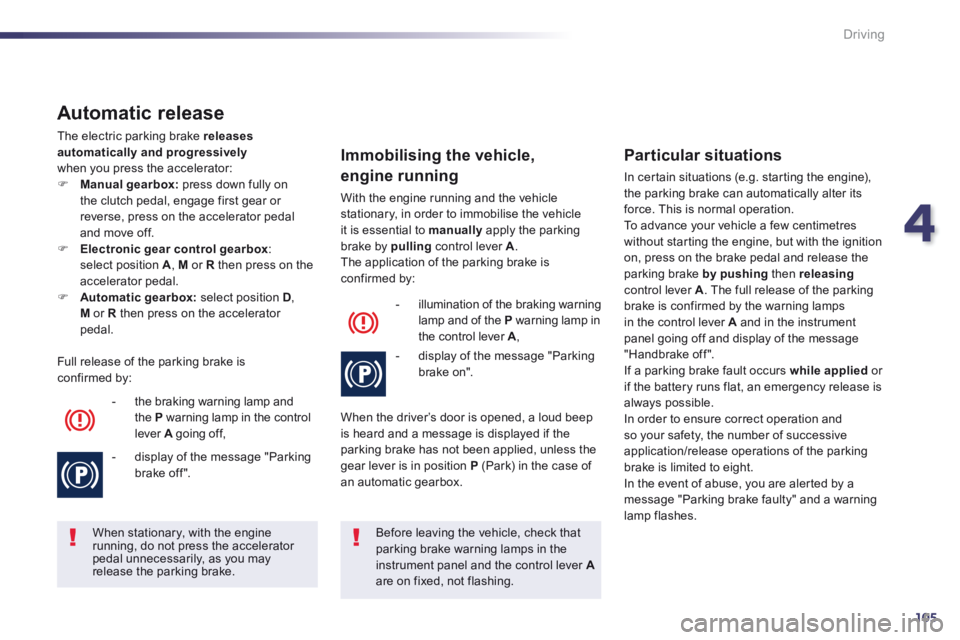
4
105
Driving
Automatic release
The electric parking brake releases automatically and progressivelywhen you press the accelerator: Manual gearbox: press down fully on the clutch pedal, engage first gear or reverse, press on the accelerator pedal and move off. Electronic gear control gearbox : select position A , M or R then press on the accelerator pedal. Automatic gearbox: select position D , M or R then press on the accelerator pedal.
Full release of the parking brake is confirmed by:
- the braking warning lamp and the P warning lamp in the control lever A going of f, A going of f, A
- display of the message "Parking brake off ".
When stationary, with the engine running, do not press the accelerator pedal unnecessarily, as you may release the parking brake.
Before leaving the vehicle, check that parking brake warning lamps in the instrument panel and the control lever Aare on fixed, not flashing.
Immobilising the vehicle,
engine running
With the engine running and the vehicle stationary, in order to immobilise the vehicle
it is essential to manually apply the parking brake by pulling control lever A . The application of the parking brake is confirmed by:
- illumination of the braking warning lamp and of the P warning lamp in the control lever A ,
- display of the message "Parking brake on".
When the driver’s door is opened, a loud beep is heard and a message is displayed if the parking brake has not been applied, unless the gear lever is in position P (Park) in the case of an automatic gearbox.
Particular situations
In certain situations (e.g. starting the engine), the parking brake can automatically alter its force. This is normal operation.
To advance your vehicle a few centimetres without starting the engine, but with the ignition on, press on the brake pedal and release the parking brake by pushing then releasingcontrol lever A . The full release of the parking brake is confirmed by the warning lamps in the control lever A and in the instrument panel going off and display of the message "Handbrake off ". If a parking brake fault occurs while applied or if the battery runs flat, an emergency release is always possible. In order to ensure correct operation and so your safety, the number of successive application/release operations of the parking brake is limited to eight. In the event of abuse, you are alerted by a message "Parking brake faulty" and a warning lamp flashes.
Page 108 of 352
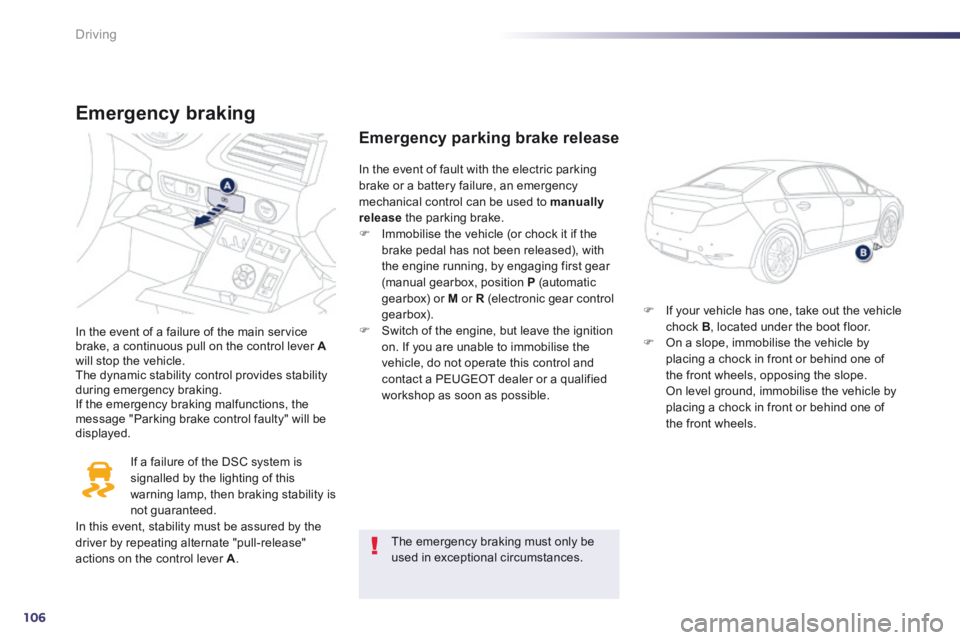
106
Driving
Emergency braking
In the event of a failure of the main service brake, a continuous pull on the control lever Awill stop the vehicle. The dynamic stability control provides stability during emergency braking. If the emergency braking malfunctions, the message "Parking brake control faulty" will be displayed.
If a failure of the DSC system is signalled by the lighting of this warning lamp, then braking stability is not guaranteed. In this event, stability must be assured by the
driver by repeating alternate "pull-release" actions on the control lever A .
Emergency parking brake release
If your vehicle has one, take out the vehicle chock B , located under the boot floor. On a slope, immobilise the vehicle by placing a chock in front or behind one of the front wheels, opposing the slope. On level ground, immobilise the vehicle by placing a chock in front or behind one of the front wheels.
In the event of fault with the electric parking brake or a battery failure, an emergency mechanical control can be used to manually release the parking brake.
Immobilise the vehicle (or chock it if the brake pedal has not been released), with the engine running, by engaging first gear (manual gearbox, position P (automatic gearbox) or M or R (electronic gear control gearbox). Switch of the engine, but leave the ignition on. If you are unable to immobilise the vehicle, do not operate this control and contact a PEUGEOT dealer or a qualified workshop as soon as possible.
The emergency braking must only be used in exceptional circumstances.
Page 109 of 352
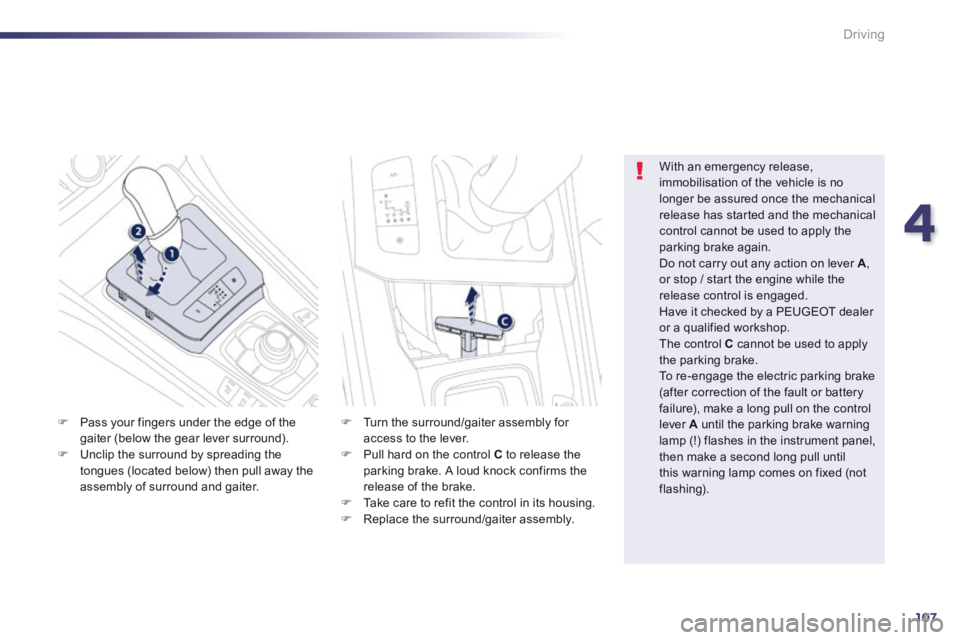
4
107
Driving
Pass your fingers under the edge of the
gaiter (below the gear lever surround). Unclip the surround by spreading the tongues (located below) then pull away the assembly of surround and gaiter.
With an emergency release, immobilisation of the vehicle is no longer be assured once the mechanical release has started and the mechanical
control cannot be used to apply the parking brake again. Do not carry out any action on lever A , or stop / start the engine while the release control is engaged. Have it checked by a PEUGEOT dealer or a qualified workshop. The control C cannot be used to apply the parking brake. To re-engage the electric parking brake (after correction of the fault or battery failure), make a long pull on the control lever A until the parking brake warning lamp (!) flashes in the instrument panel, then make a second long pull until this warning lamp comes on fixed (not flashing).
Turn the surround/gaiter assembly for
access to the lever. Pull hard on the control C to release the parking brake. A loud knock confirms the release of the brake. Take care to refit the control in its housing. Replace the surround/gaiter assembly.
Page 111 of 352
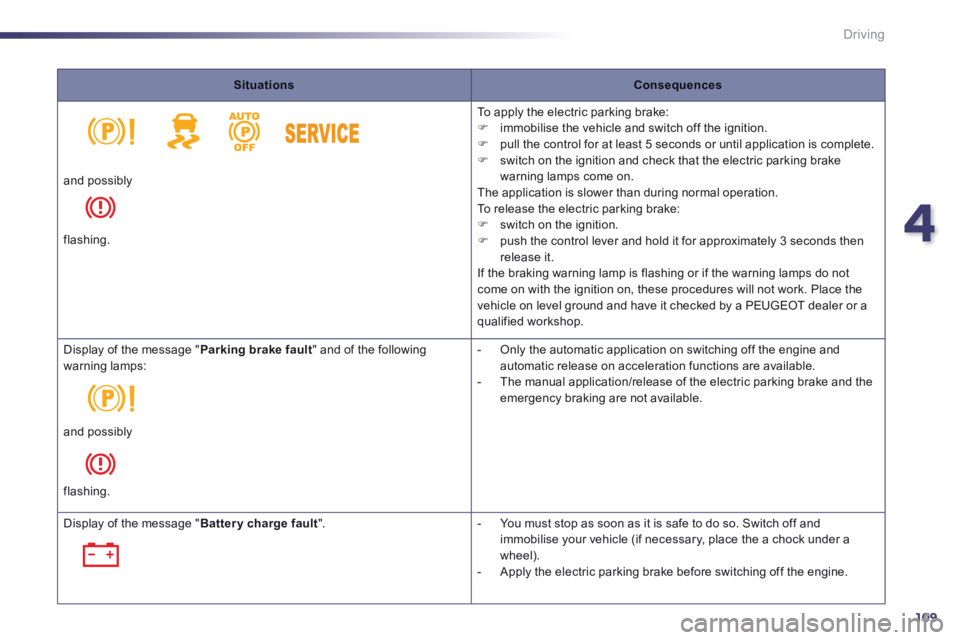
4
109
Driving
SituationsConsequences
To apply the electric parking brake: immobilise the vehicle and switch off the ignition. pull the control for at least 5 seconds or until application is complete. switch on the ignition and check that the electric parking brake warning lamps come on. The application is slower than during normal operation. To release the electric parking brake:
switch on the ignition. push the control lever and hold it for approximately 3 seconds then release it. If the braking warning lamp is flashing or if the warning lamps do not come on with the ignition on, these procedures will not work. Place the vehicle on level ground and have it checked by a PEUGEOT dealer or a qualified workshop.
and possibly
flashing .
Display of the message " Parking brake fault " and of the following warning lamps: - Only the automatic application on switching off the engine and automatic release on acceleration functions are available. - The manual application/release of the electric parking brake and the emergency braking are not available.
and possibly
flashing .
Display of the message "Battery charge fault". - You must stop as soon as it is safe to do so. Switch off and immobilise your vehicle (if necessary, place the a chock under a wheel). - Apply the electric parking brake before switching off the engine.
Page 113 of 352
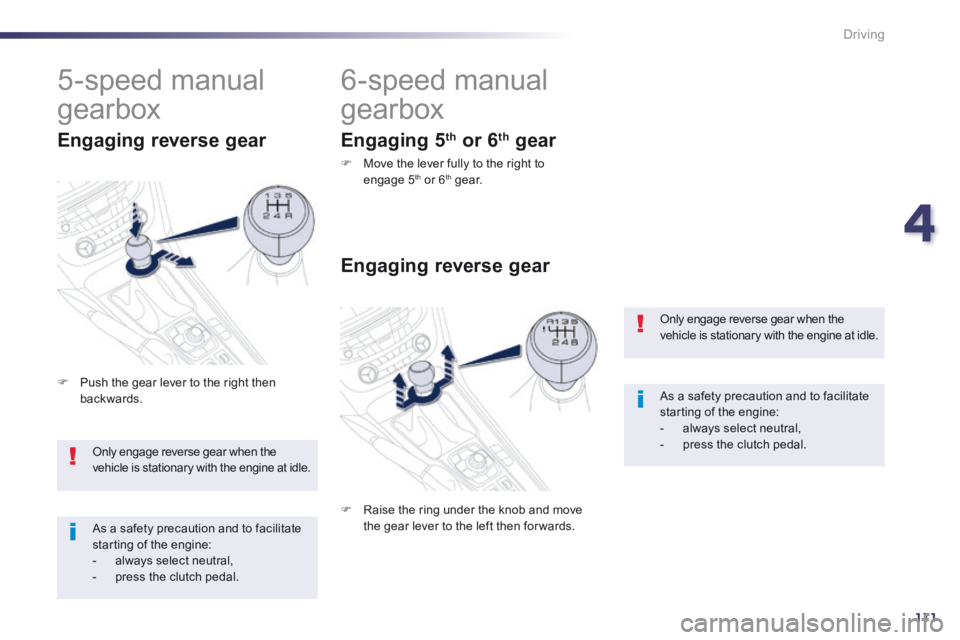
4
111
Driving
Only engage reverse gear when the vehicle is stationary with the engine at idle.
As a safety precaution and to facilitate starting of the engine: - always select neutral, - press the clutch pedal.
6-speed manual
gearbox
Engaging 5 th or 6 th gear
Move the lever fully to the right to engage 5 th or 6 th g e a r.
Only engage reverse gear when the vehicle is stationary with the engine at idle.
As a safety precaution and to facilitate starting of the engine: - always select neutral, - press the clutch pedal.
5-speed manual
gearbox
Push the gear lever to the right then backwards.
Engaging reverse gear
Engaging reverse gear
Raise the ring under the knob and move the gear lever to the left then for wards.
Page 114 of 352
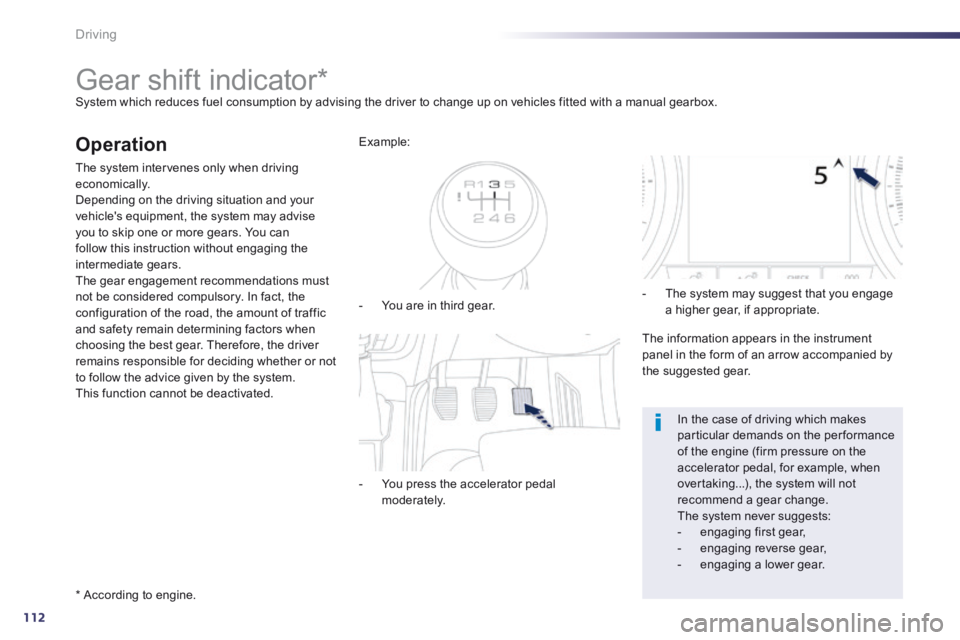
112
Driving
Gear shift indicator * System which reduces fuel consumption by advising the driver to change up on vehicles fitted with a manual gearbox.
Operation
The system intervenes only when driving economically. Depending on the driving situation and your vehicle's equipment, the system may advise you to skip one or more gears. You can follow this instruction without engaging the intermediate gears. The gear engagement recommendations must not be considered compulsory. In fact, the configuration of the road, the amount of traffic and safety remain determining factors when choosing the best gear. Therefore, the driver remains responsible for deciding whether or not to follow the advice given by the system. This function cannot be deactivated.
* According to engine.
- You are in third gear.
Example:
- You press the accelerator pedal moderately.
- The system may suggest that you engage a higher gear, if appropriate.
The information appears in the instrument panel in the form of an arrow accompanied by the suggested gear.
In the case of driving which makes particular demands on the performance of the engine (firm pressure on the accelerator pedal, for example, when overtaking...), the system will not recommend a gear change. The system never suggests: - engaging first gear, - engaging reverse gear, - engaging a lower gear.